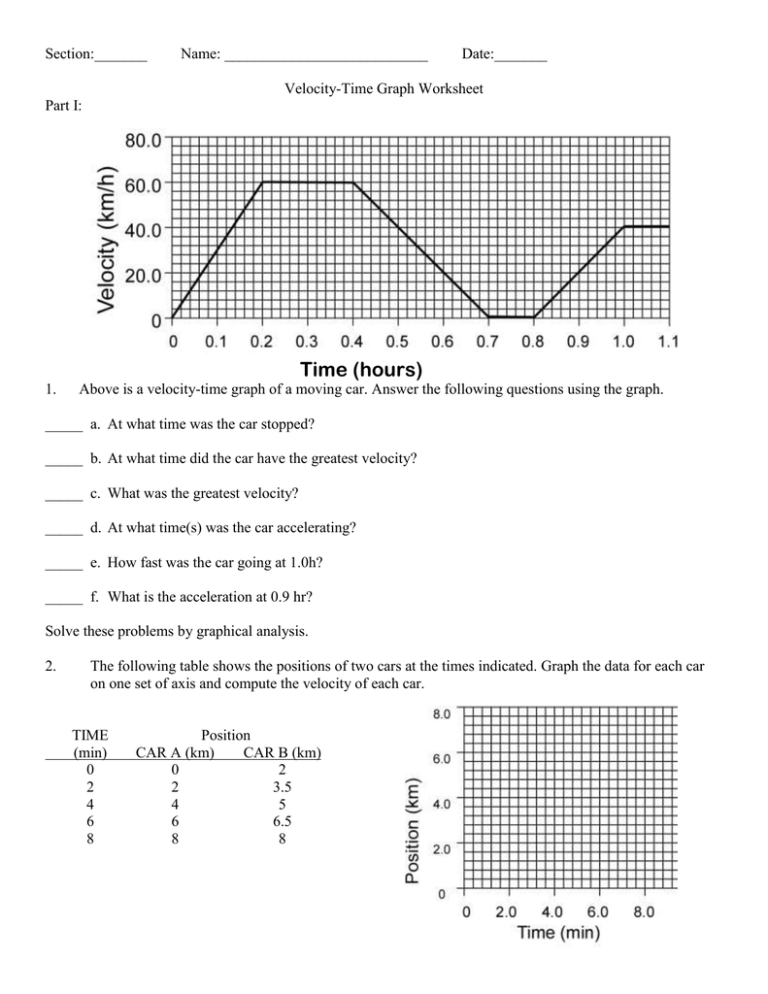Have you ever wondered how a speeding car, a gracefully soaring bird, or even a simple bouncing ball moves? The science of motion, known as kinematics, is the key to understanding the world around us. And what better way to delve into this fascinating subject than through the lens of graphing motion worksheets? These worksheets serve as powerful tools to visualize and analyze motion, transforming abstract concepts into tangible insights.

Image: worksheetlibmarko.z19.web.core.windows.net
This comprehensive guide will be your compass through the world of graphing motion worksheets. We will explore the essential concepts, navigate the intricate details, and unlock the secrets behind the answers to these valuable exercises. By the end, you’ll not only understand the answers but also gain a deeper appreciation for the science of motion itself.
Deciphering the Language of Motion: Introducing Position, Distance, and Displacement
Before we dive into the intricacies of graphing motion, let’s lay the foundation with the fundamental concepts. Imagine you’re walking from your house to the park. This simple act involves key elements that form the basis of kinematics:
-
Position: Your starting point, your house, is your initial position. As you walk towards the park, your position changes, describing your location at any given moment.
-
Distance: The total length of your path to the park, including any turns or loops you might take, is your total distance.
-
Displacement: The straight-line distance from your starting point (house) to your final destination (park) is your displacement. It’s a direct measure of the change in your position.
Visualizing Motion: The Power of Graphs
Graphs are more than just static images. They are dynamic representations that bring motion to life. Imagine a graph with time on the horizontal axis and some measure of motion, like position or velocity, on the vertical axis. By plotting points on this graph, we create a visual story of an object’s movement.
Different Types of Graphs:
-
Position-Time Graphs: These graphs depict an object’s position at different points in time. They reveal how fast an object is moving (slope of the line) and its direction (positive or negative direction of the slope).
-
Velocity-Time Graphs: Instead of position, these graphs show an object’s velocity (speed and direction) over time. The area under the curve represents displacement, providing insights into the overall change in position.
-
Acceleration-Time Graphs: These graphs focus on how an object’s velocity changes over time. The area under the curve represents the change in velocity, while the slope represents acceleration.
Charting a Course through Graphs: A Detailed Look at Graphing Motion Worksheets
Graphing motion worksheets are designed to help you master the art of interpreting and creating these powerful visual representations. Here’s a breakdown of the common types of questions:
1. Interpreting Motion Graphs:
-
Identifying Position, Velocity, and Acceleration: These questions ask you to analyze a given graph and extract information about an object’s position, velocity, and acceleration at specific points in time or over certain intervals.
-
Determining the Type of Motion: The shape of a graph reveals important information about the type of motion an object is experiencing. Is it moving at a constant velocity, accelerating, or decelerating?
2. Creating Motion Graphs:
-
Plotting Data Points: You’ll be provided with a set of data points (positions at different times, velocities at different times, etc.) and tasked with plotting them on a graph.
-
Drawing Motion Graphs Based on Scenarios: You might be given a written description of an object’s motion and asked to create the corresponding position-time, velocity-time, or acceleration-time graph.
3. Applying the Concepts:
- Solving Problems Involving Motion: Many worksheets incorporate real-world scenarios, challenging you to apply your understanding of motion graphs to solve problems involving distance, displacement, speed, velocity, and acceleration.

Image: www.e-streetlight.com
The Importance of Practice: Unlocking the Answers with Confidence
Graphing motion worksheets are not just about getting the right answers. They are about developing a deep understanding of the concepts and building the skills needed to confidently analyze and interpret motion in various scenarios.
Remember, practice is key! Work through the examples, focus on the explanations, and don’t hesitate to ask for help if you encounter difficulties. The journey of mastering the answers is equally as important as the destination of solving them.
Expert Insights to Boost Your Understanding
-
Relate Graphs to Real-World Scenarios: Visualizing the motion of objects in the real world can make the concept of graphs easier to grasp. Imagine a car accelerating from rest, or a ball thrown vertically upwards, and visualize how their motion would be represented on a position-time or velocity-time graph.
-
Seek out Visual Resources: Videos, simulations, and animations can provide a dynamic understanding of motion graphs. There are numerous online resources available that can supplement your learning experience with interactive visualizations.
Answer Key Graphing Motion Worksheet Answers
A Call to Action: Embrace the Power of Motion
Graphing motion worksheets are not just academic exercises but practical tools that empower you to understand the complex world around us. By mastering the concepts and techniques, you’ll be able to analyze the movement of just about anything, from a falling object to the intricate dance of a planet in our solar system.
So, take the leap, dive deep into the world of motion, and let the answers reveal the beauty and wonder of the way things move.






